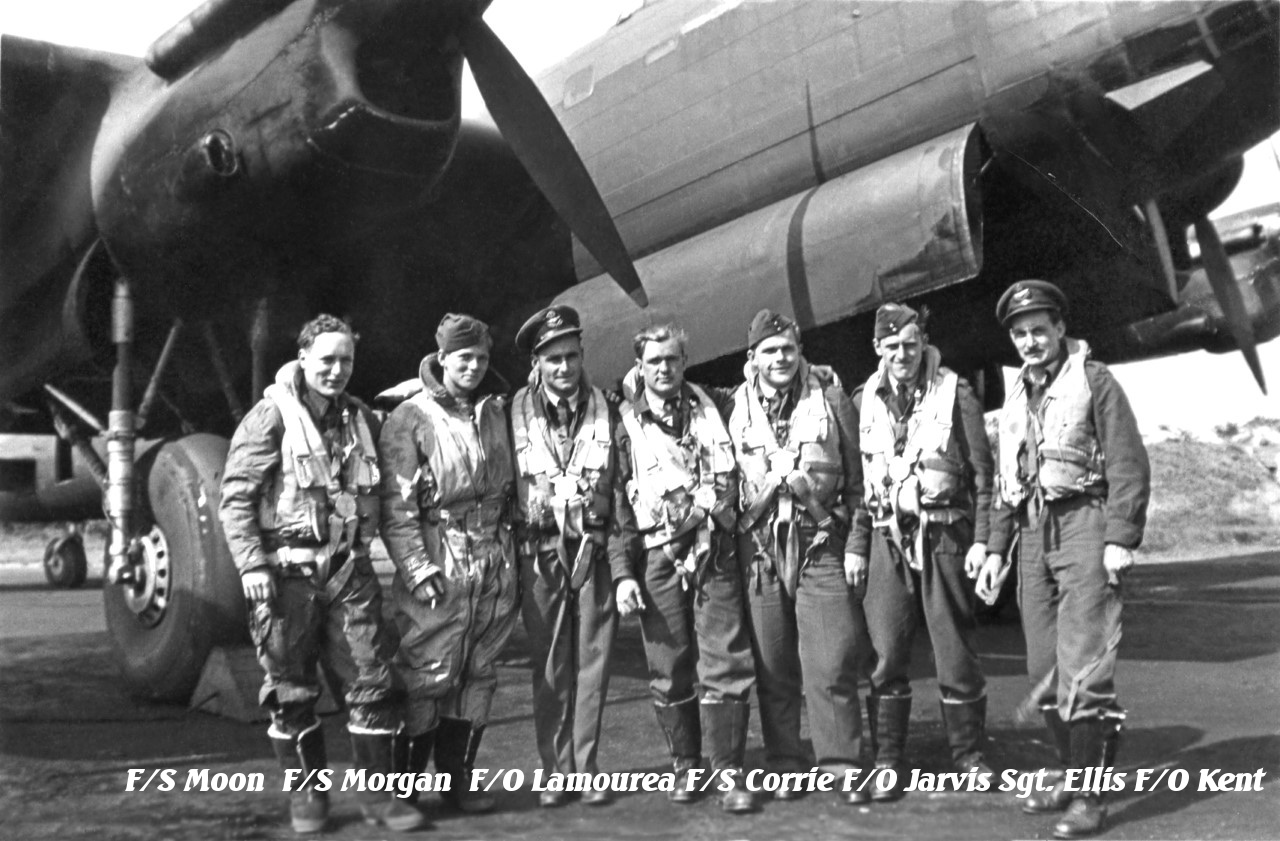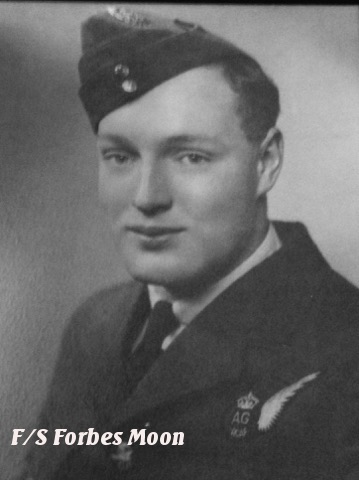Crew of F/L Roy Kent DFC part 2

Our Thanks to L. Jarvis for sharing his photos and the research on the crew who his father served with.
419 Squadron
After completion of training at No.24 O.T.U and with the addition of Sgt. Ellis as the Flight Engineer at No.1666 the crew were posted to 419 arriving on May 26th 1944.
With all the training completed the crew were anxious to get on with the job at hand. The crew though would have to wait a few weeks as their captain had to complete his two sorties as 2nd. Pilot. These were accomplished on May31/June 1 and the second sortie on June4/5. Although it would be a few more days yet before the first operation as a crew on June 9/10.
Lancaster KB724 VR-K
 Serial number KB724 arrived at 419 at the beginning of May of 1944, the first operational flight was
on the night of May 9/10 with F/S Hartford as the pilot.
Serial number KB724 arrived at 419 at the beginning of May of 1944, the first operational flight was
on the night of May 9/10 with F/S Hartford as the pilot.The Kent crew flew on two other notable 419 Lancasters, KB700 VR-Z "Ruhr Express" on one operation. The second Lancaster, KB726 VR-A, the aircraft best known for the heroic actions of P/O Mynarski and his subsequent posthumous awarding of the Victoria Cross. The Roy Kent crew was flying KB726 the afternoon of the loss of VR-A.
KB724 found itself in a number of combat situations prior to it's history with F/O Kent and crew. On May 27th Sgt. Newton rear gunner for P/O Tee's crew drove off a FW190 and then on July 4th, an unusual occurrence in that the gunner involved was WO Whyte the Bomb Aimer, one of the very few times when it was not a gunner who defended the bomber.
The Kent crew first twelve operations were carried out on KB724. The Lancaster and the skill of the crew would always bring them home safely even as the enemy tried its best to bring them down.
June 14/15 St.Pol an "uneventful trip"
The crews report on this their fourth sortie downplays the events which actually occurred that night. Kent's crew as with the majority of the crews looked at what happened during the flight to and from the target as just part of the job. Therefore the last sentence in the Squadron ORB summary for KB724 on that date which simply states an "uneventful trip" is not surprising but misleading.
Along with fifteen other 419 squadron Lancasters the Kent crew joined the bomber stream from other squadrons in the bombing operation on the road and rail junctions at St. Pol. Bombing was from 11,000 feet with heavy cloud cover and enemy action was described as light. KB724's "uneventful trip" included a taste of this light enemy action
F/L Wilson the Squadron Gunnery Leader described KB724's encounter in the Combat Report this way:
"When leaving the target area on the night of 14.6.44, Lancaster K of 419(RCAF) Squadron was intercepted by a
Ju88. enemy aircraft was first observed by Rear Gunner off the port beam at a range of 400 yds. flying parallel in the
dark part of the sky; momentarily illuminated by a flash from the target. At that moment he was observed to bank and close in. rear Gunner gave a corkscrew
to port and opened fire at a range of 200 yrds. Enemy aircraft slid across the stern and broke away
starboard quarter down and was not seen again."
No damage to either aircraft was reported.June 12 Triverny
After two lengthy delays sixteen 419 aircraft left for Triverny, KB724 with the Kent crew was among them. Some of the "slight enemy action" punched a hole through the windscreen of the aircraft.
On approach to the bombing site the front windscreen of the aircraft was blown out by flak (airspeed 135 mph). Roy Kent dropped his face on impact and was cut in the forehead by a piece of flak. His face was cut from the windscreen glass some of it (in powder form ) got in his eyes.
Fred Lamourea (Bomb Aimer) said it looked worse than it was. Roy said he kept the piece of flak as a good luck charm for a long time but eventually lost it.
June 16/17 Sterkade
There were a number of Combat Reports filed as the different squadron crews returned from this operation. There was little cloud cover and enemy aircraft and flak was very active, for 419 Squadron it was a night with two experienced crews lost and VR-G badly shot up by flak and cannon fire from night fighters.
The gallant efforts of all the 419 gunners drove off many attacks, and F/O Kent and his crew were one of those who got a chance to fight back and drive off the Luftwaffe attackers.
The details given in P/O Morgan's commendation give some idea of what occurred.
"Pilot Officer Morgan has proved himself to be a most reliable and efficient gunner.
He has completed numerous sorties over enemy territory. On one occasion when detailed
to attack St.Pol his aircraft was attacked by a Junkers 88 but due to the quick and
skilful direction of Pilot Officer Morgan the enemy aircraft was successfully evaded.
Again in June 1944, when on another mission, his aircraft was attacked by a Focke Wulf 190.
Once again he was responsible for extricating his aircraft and crew from what might have
been a fatal encounter. Pilot Officer Morgan's fine fighting spirit and calmness in the
face of danger have set an inspiring example to the other members of his crew."

August 9, 1944 Acquet
Before they had left the safety of the English country side behind them, VR-K had lost the use of two Merlin engines.
Roy was determined to complete the mission even after losing the second engine. He discussed it with the crew and gave a few of the non-essentials the option to bail out over England. They decided to stay. As long as the Navigator told Roy he could get them to the target on time by adjusting the route he was determined to complete the mission. He indicated that normal protocol called for dumping the bombs over the water and returning to base. After a very hairy landing (Kentís words from his log) the cause of the engine failure turned out to be the maintenance crew had put the wrong cotter pins in the linkage. When Roy was asked if he wanted to press charges, he apparently refused saying "We made it back didn't we?".( Additional information was from the 2005 crew reunion.)
The details given in F/O Kent's commendation give some idea of what occurred.
In all his operations against the enemy Flying Officer Kent has shown great determination to attack his targets.
One night in August 1944 he was engaged on a mission to Acquet. Shortly after take-off the port outer engine
failed and before crossing the English coast one of the starboard engines also failed. Nevertheless,
Flying Officer Kent flew on to the target and completed his mission, afterwards returning to base
where he executed a masterly landing in exceedingly difficult circumstances. Flying Officer Kent
has displayed high courage, skill and determination.
August 20th Brunswick
Bomber Command used this operation as a test of the individual crew use of H2S radar in locating and bombing the selected target. The Pathfinder Squadrons were not used and the results were far from successful so much so that some towns 20 miles from the target were bombed by mistake.
Seventeen crews were lost during the operation. F/O Kent found that the best way to avoid the night fighters and to get home was to wave hop across the North Sea using the low cloud as cover.

Crew Promotion and Screening
 By the beginning of August 1944 both Sgt. Moon and Morgan were promoted to Flight Sergeants. Morgan and
Moon were then commissioned to Pilot Officers the very next month, on September 7th.
By the beginning of August 1944 both Sgt. Moon and Morgan were promoted to Flight Sergeants. Morgan and
Moon were then commissioned to Pilot Officers the very next month, on September 7th.Sgt. Ellis was commissioned to Pilot Officer by September 15th. of that year.
F/O Kent DFC was promoted to A/F/L prior to the October 4th. 1944 operation to Bergen.
On November 3rd, 1944 F/L Kent, F/O Jarvis and F/O Lamourea were posted to "R" Depot. P/O Moon and Morgan DFC were posted to "R" Depot on November 14th. 1944 . P/O Ellis was posted to A.C.A.C. for non-operational duty on November 6th. also in 1944
Information on P/O Corrie and his posting could not be found.